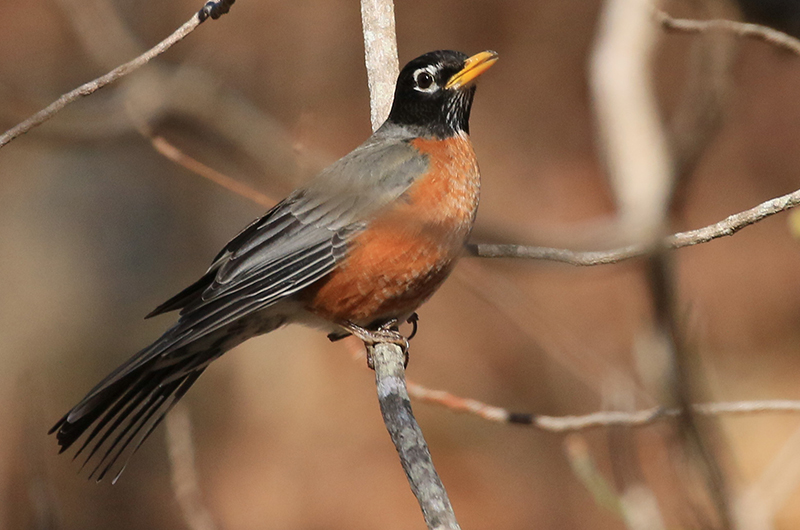It is winter time and, no surprise, the weather is cold. This is not the time of year to expect to hear birds singing. But I have been hearing Carolina wrens singing just about every day this month. Not only their staccato chattering alarm call, but their boisterous, loud, whistled and usually three-syllabled song that is repeated over and over again. The song sounds something like “teakettle” or “committee.”
Unexpectedly, early on Jan. 20, I heard two other species singing in my yard. One was the clearly whistled fee-bee of the black-capped chickadee, with both notes at the same pitch (unlike off-Island chickadees). The other song was not the typical song sparrow song. It was only the jumble of notes in the middle of its usual song. This softer song is how first winter song sparrows typically begin singing. Their song will improve once they hear adult song sparrows singing.
We will enjoy any and all signs of an approaching, but still distant, spring.
Bird Sightings
The most exciting sighting was by Cynthia Bloomquist and Thaw Malin, who photographed a fox sparrow in their yard on Jan. 23. Not surprisingly, it was seen with their usual flock of white-throated sparrows. We do not see very many of these large reddish sparrows. They also spotted a yellow-bellied sapsucker in their yard on Jan. 21.
Winter wrens skulk around in the dense underbrush and only briefly pop into view. So I was pleased to see one on my Jan. 24 visit to Waskosim’s Rock Reservation. It popped up out of a dense stand of greenbrier near the Mill Brook, and was accompanied by a hermit thrush, several robins, and both red- and white-breasted nuthatches. A sharp-shinned hawk and several eastern bluebirds elsewhere on the property were my other highlights. I also spotted a flock of bluebirds in Oak Grove Cemetery in Oak Bluffs on Jan. 23, and Jonathan Lange reports bluebirds along Stoney Hill Road on Jan. 25. Numerous observers have them visiting their feeders.
Robins have been widely reported this week. The best story comes from Paul August. On Jan. 20, he put out a birdbath after reading one of my recent columns. The water immediately attracting a curious squirrel, a wild turkey, and a flock of perhaps 20 robins. Thirty minutes later they were still at the bird bath. His mother, Jean August, was excited to hear this as she has to do her birdwatching vicariously through his reports. The robins were still there as of Jan. 24.
Another flock of 30 robins was reported by Deb Orazem on Jan. 20, and I was surprised to find four of them perched on the railing of my deck on Jan. 24.
Razorbills are still frequenting our shores. On Jan. 18, Bob Shriber spotted five razorbills in the waters off Lighthouse Road in Aquinnah, as well as five fish crows. The troika of Margaret Curtin, Luanne Johnson, and Nancy Weaver spotted three razorbills and 17 long-tailed ducks off East Chop on Jan. 18. And John Nelson found a dead razorbill on Menemsha Beach on Jan. 22. Winter is stressful.
On the waterfowl front, Jeff Bernier spotted a gadwall at Sheriff’s Meadow Sanctuary on Jan. 18. Jason Flanders spotted a flock of ring-necked ducks on the Duarte’s Pond that is near Lambert’s Cove Road on Jan. 19, and I found an unexpected northern pintail at Sarson’s Island on Jan. 22.
An adult bald eagle was perched on the osprey pole near Cedar Tree Neck, as reported by Frank Flanders on Jan. 20. Karen English also saw the eagle there that day, and Shelley Scheuer had one that day near Look’s Pond. Albert Fischer spotted an immature bald eagle flying over Squibnocket Pond the day before.
Elsewhere on the hawk front, the kestrel is still hanging out at Katama Farm. Kenneth LaVigne spotted it on Jan. 19. The next day Jeff Bernier saw it chasing a harrier, and the day after that Hans Goeckel observed it chasing two harriers. David Padullo reports a peregrine falcon at Little Beach on Jan. 18 and three species (northern harrier, sharp-shinned hawk and merlin) at Katama Farm the day before.
There have been two more sightings of the barred owl. Joel Graves’ seven-year-old son Eli heard the barred owl calling and was able to get almost under the tree it was in and recorded its call. They saw its shadow as it flew away on Jan. 22, the day after Michael Ditchfield heard one calling from Dark Woods.
Lingering songbirds include 30 or so red-winged blackbirds that visit Randy Rynd’s feeders. There are brown-and-white striped immature males as well as the more easily recognized all black males. She also reports three brown-headed cowbirds and a lone raven visited on Jan. 20. Allan Keith reports that the cowbirds attempting to overwinter at his feeder have increased to 10 individuals. Francesca Zeta, Sioux Eagle and Betsy Donnelly reported pine warblers are visiting their feeders regularly.
Lingering shorebirds include Allan Keith’s sighting of two greater yellowlegs along the shoreline of Menemsha Channel on Jan. 20. Elizabeth Luce photographed a female belted kingfisher — with its brown band across its chest — at Little Duarte’s Pond on Jan. 20. The overwintering kingfishers I have seen are males, lacking that brown band. And David Padullo reports that the great egret is still at Sheriff’s Meadow, as of Jan. 19.
Please email your sightings to birds@mvgazette.com.
Robert Culbert is an ecological consultant with Nature Watch LLC living in Vineyard Haven.











Comments
Comment policy »